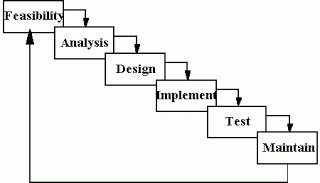System Development Life Cycle
The image below is the classic Waterfall model methodology, which is the first SDLC method and it describes the various phases involved in development.
 Briefly on different Phases:
Briefly on different Phases:Feasibility : The feasibility study is used to determine if the project should get the go-ahead. If the project is to proceed, the feasibility study will produce a project plan and budget estimates for the future stages of development
Requirement Analysis and Design : Analysis gathers the requirements for the system. This stage includes a detailed study of the business needs of the organization. Options for changing the business process may be considered. Design focuses on high level design like, what programs are needed and how are they going to interact, low-level design (how the individual programs are going to work), interface design (what are the interfaces going to look like) and data design (what data will be required). During these phases, the software’s overall structure is defined. Analysis and Design are very crucial in the whole development cycle. Any glitch in the design phase could be very expensive to solve in the later stage of the software development. Much care is taken during this phase. The logical system of the product is developed in this phase.
Implementation: In this phase the designs are translated into code. Computer programs are written using a conventional programming language or an application generator. Programming tools like Compilers, Interpreters, Debuggers are used to generate the code. Different high level programming languages like C, C++, Pascal, Java are used for coding. With respect to the type of application, the right programming language is chosen.
Testing: In this phase the system is tested. Normally programs are written as a series of individual modules, these subject to separate and detailed test. The system is then tested as a whole. The separate modules are brought together and tested as a complete system. The system is tested to ensure that interfaces between modules work (integration testing), the system works on the intended platform and with the expected volume of data (volume testing) and that the system does what the user requires (acceptance/beta testing).
Maintenance : Inevitably the system will need maintenance. Software will definitely undergo change once it is delivered to the customer. There are many reasons for the change. Change could happen because of some unexpected input values into the system. In addition, the changes in the system could directly affect the software operations. The software should be developed to accommodate changes that could happen during the post implementation period.
The WaterFall methodology was a very important one when it was launched and has revolutionized the working of software development for business platforms. Great article! 😀
bridge box